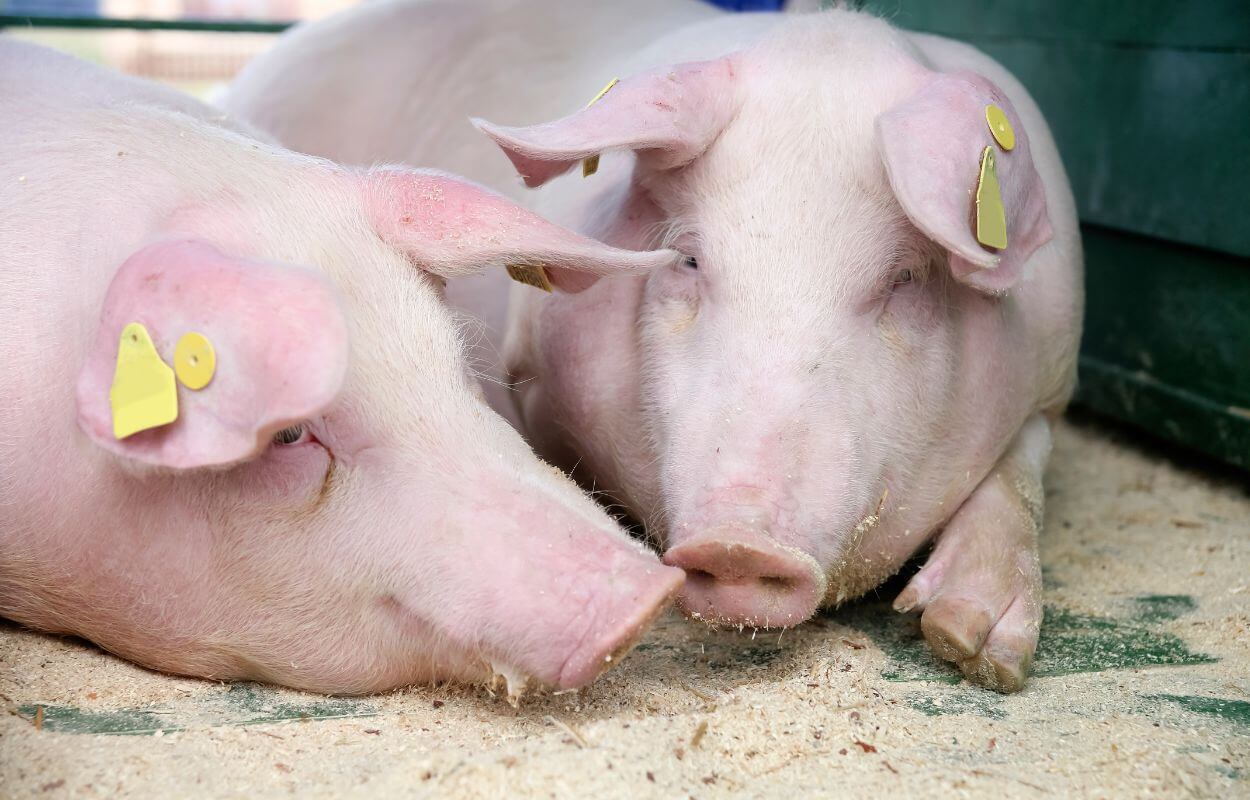
Landrace pig is one of your safe choices as a farmer if you are thinking of growing or developing a business based on pig breeds for meat.
With a special morphology, Landrace is a breed of pigs preferred by those who want to produce pork because it has lean meat with very little fat from which other products such as bacon or pork carcasses can result.
Today, we will discuss the origin and history of landrace pigs, as well as how to raise them, and the advantages and disadvantages associated with this breed.
Contents
Origin & History
The Landrace pig originates from Denmark.
The creation of this breed of pigs was not a simple process, but one that stretched over several years in which several tests and breedings were carried out under strict control and supervision by the Danish government.
The Landrace pig breed was successfully completed between 1850 and 1907 by breeding some local pig breeds with English ones, such as the Great White or the Middle White, which were brought directly from England.
The Landrace pig breed was so successful that Denmark became the leading bacon-exporting country. Their main focus was the production of the English’s favorite bacon, namely the one called “Wiltshire” bacon. Due to this enormous success, the Danes refused to export this live pig breed until the Second World War.
The first export of Landrace pigs took place in America and consisted of 24 live pigs. The export was possible due to an arrangement between the United States Department of Agriculture and the Ministry of Foreign Affairs in Denmark. In America, this breed was submitted to further tests and crosses resulting in four new breeds.
Restrictions on the export of live Landrace pigs ended in 1949 when the Danish Ministry of Foreign Affairs agreed to the USDA’s proposal to lift restrictions on the propagation of purebred Landraces in America. It didn’t last long, and in 1950 the American Landrace Association was founded with the main purpose of selling purebred breeding animals.
What is a Landrace pig?
The Landrace pig is a domestic and commercial breed that is raised worldwide for pork production.
Landrace Pig Breeds
There are more than 20 types of Landrace pig breeds, but some such as the American Landrace pig, British Landrace pig, or Danish Landrace pig are more common and popular than others.
American Landrace Pigs
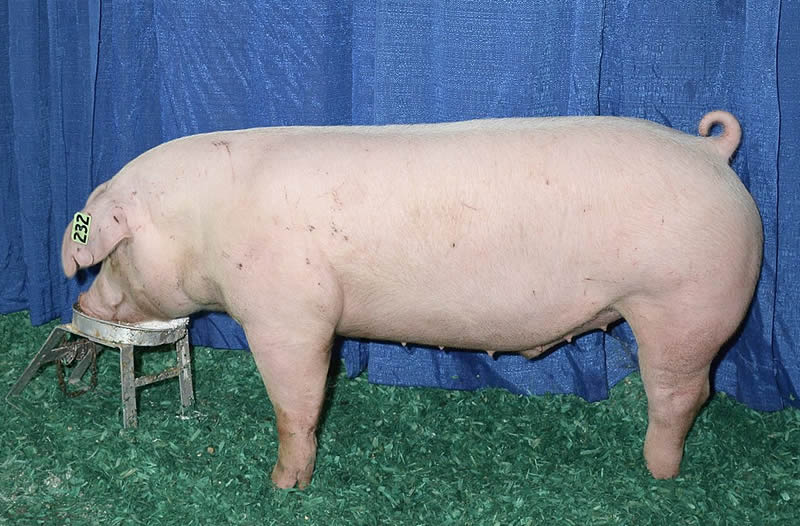
The American Landrace pig is the first descendant of the original Landrace pig from Denmark. It was cross-breed in America after Denmark agreed in 1939 to export 24 live pigs for more research.
In terms of appearance, The American Landrace pig has white skin, a long horizontal torso with 16 or 17 ribs, and some big, long, and dropping ears.
British Landrace Pigs
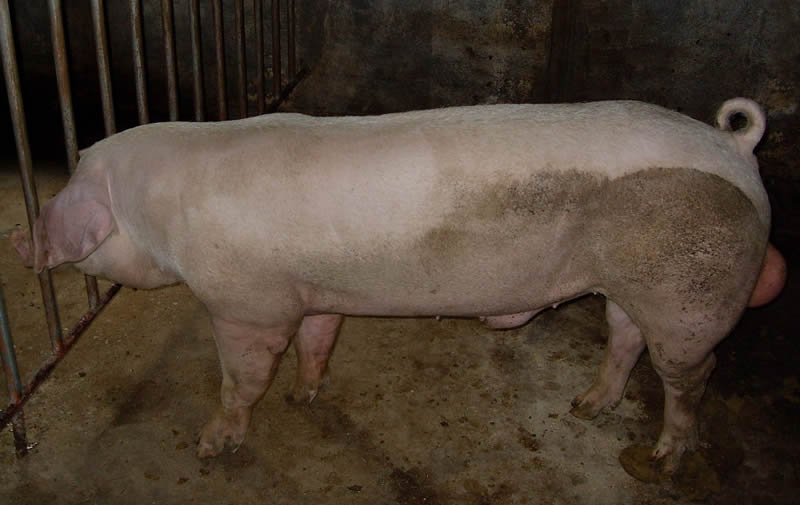
The British Landrace pig is the most popular pig breed in the United Kingdom, especially in the East and Yorkshire.
It was created after 1949 when 12 Landrace pigs were brought to the United Kingdom from Scandinavia. Bred and raised for pork and bacon, these pigs have long bodies, small heads with long, heavy ears, and white skin.
The British Landrace pig is considered a unique breed of pig.
This uniqueness comes from the fact that in 1980 the British Landrace breed was genetically developed by adding new bloodlines from Finland and Norway.
Danish Landrace Pigs
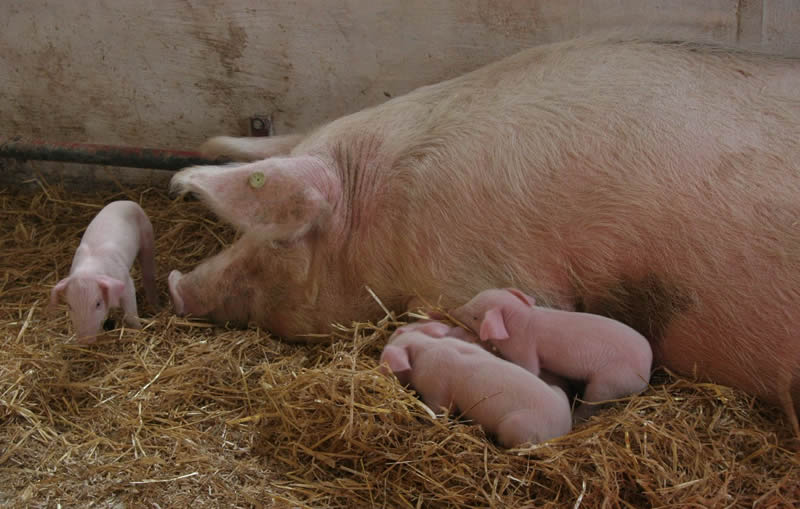
The Danish Landrace pig is the original breed from which all others are derived.
This pig has a long body with a very slightly arched back, some long and bent ears, a small head, and a long snout. Two skin colors are distinguished for this breed: white and piebald.
Landrace Pig Characteristics
When it comes to the Landrace pig characteristics, it differs from other breeds by size, weight, skin color, and other morphological characteristics.
Physical Characteristics
Like any other pig breed, Landrace pigs’ physical characteristics and overall appearance make them stand out among other types of pigs.
Size

The size of Landrace pigs is large, measuring between 63 to 71 inches (160 to 180 cm) in length for males and 62 to 70 inches (158 to 170 cm) for females, with a height of over 35.5 inches (90 cm).
The size of these pigs differentiates between the two sexes, with the female being smaller than the male.
Hair and Skin
Landrace pigs have short, straight hair and white to pink skin.
The hair is fine and not very dense, while the skin is smooth, elastic, without wrinkles and folds. The pinkish-white skin is a distinguishing feature of these pigs.
Good to know: Landrace pigs do not have any black spots on their skin.
Body, Back, Chest
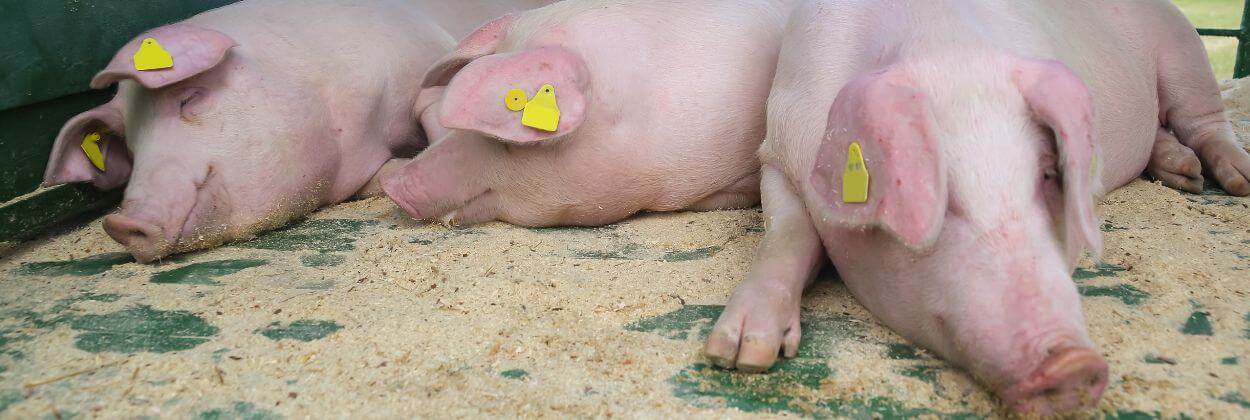
The body of a Landrace pig is long and rectangular in shape. Compared to other pig breeds such as the Red Wattle Pig or Hereford Pig, Landrace pigs have elongated bodies.
In addition to their body shape, Landrace pigs have deep chests and well-developed, muscular shoulders, which contribute to their robust appearance.
The back is also broad and muscular. The entire backline of a Landrace pig is extremely straight, running from the shoulders to the hindquarters.
Ribcage
The ribcage of these pigs is very deep and wide, providing plenty of room for their internal organs. Landrace pigs have sixteen or seventeen pairs of ribs.
Belly
Their belly is, like the rest of the body, very large and well-rounded. It extends from the chest area towards the hindquarters and typically has a layer of fat.
Teats
Landrace pig has 14 to 16 teats.
Legs
The legs are straight and sturdy, offering ample support to its large and long body. The length of the legs is also proportional to their body size.
Head

The head of the Landrace pig is long and narrow, but overall it is proportionate to the body size, neither too large nor very small. It also presents a slightly arched profile from the forehead to the snout.
Eyes
The eyes have medium size and are well-positioned on both sides, providing them with excellent vision.
Jowls
The jowls of Landrace pigs are prominent and well-developed, positioned on the lower part of the face around the cheeks and lower jaw. This is another distinguishing feature of Landrace pigs.
Teeth
Landrace pigs have 44 teeth when they reach adulthood.
Their teeth are strong and well-aligned. They also have tusks, which are usually more prominent in males, but they are often trimmed in commercial farming practices.
Ears
The ears are big, long, with a broad base, and taper towards the tip. They hang down a bit and cover a part of their cheeks.
Lifespan
Landrace pigs can live up to 10 to 15 years on average.
Their lifespan is quite long and can be placed alongside pasture pigs such as Vietnamese Pot-bellied pigs or Tamworth pigs due to their similar lifespan.
Growth Rate
How fast do Landacre pigs grow?

Landrace pigs grow in 5 to 6 months, which is a fast growth rate in the pig world.
According to a study by the Department of Animal Science of the University of Saskatchewan that analyzed pigs weighing between 100 and 200 lbs (45-90 kg), Landrace pigs exhibited a similar growth rate to Yorkshire pigs and Lacombe pigs.
Landrace pigs reach sexual maturity also at 5 months of age. Keep in mind that the age of sexual maturity can also be influenced by nutrition.
Weight
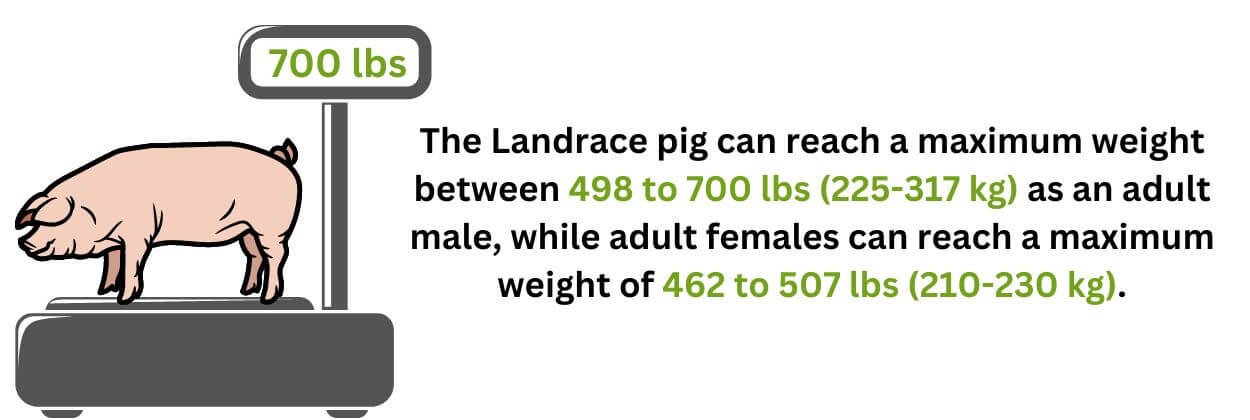
The Landrace pig can reach a maximum weight between 498 to 700 lbs (225-317 kg) as an adult male, while adult females can reach a maximum weight of 462 to 507 lbs (210-230 kg).
Still, the Landrace pig weight can be described in different stages of pig development so that Landrace piglets reach a weight of 39-44 lbs (18-20 kg) at two months, and 220 lbs (100 kg) up to 160 days of life.
Slaughter Time
Landrace pigs can be slaughtered at 6 months of age. At this age, they reach an optimal weight for meat production, typically up to 220 lbs (100 kg).
The slaughter time can vary depending on the desired weight and farm management practices.
Landrace Pig Behaviour & Habits
The temperament of Landrace pigs is calm and docile.
They are gentle, friendly, and easy to handle. Landrace pigs do not exhibit aggression and are not easily stressed as other pig breeds like Piétrain by various environmental factors.
This calm temperament makes them a suitable pig breed for husbandry, especially for new pig farmers who are learning to raise their first pig.
Landrace pigs are sociable animals and thrive in groups or herds. They can coexist with other pig breeds and even other farm animals. They are naturally curious and enjoy exploring their environment. Landrace pigs may engage in play if provided with objects like balls or other items.
Landrace pigs are extremely lively and like to have fun. After eating, they will rest, but the resting place will be chosen according to the outside temperature. If it is cold outside, then the Landrace pigs will choose the stable as a resting place, and if the outside temperature is high, you will find them sleeping in the shade or in water and mud.
During the rest period, the pigs will not respond nor will they be disturbed by any external stimulus.
If raised with access to pasture, Landrace pigs exercise their natural instinct for rooting and grazing. They use their snouts to search for food, roots, and insects in the ground.
Meat
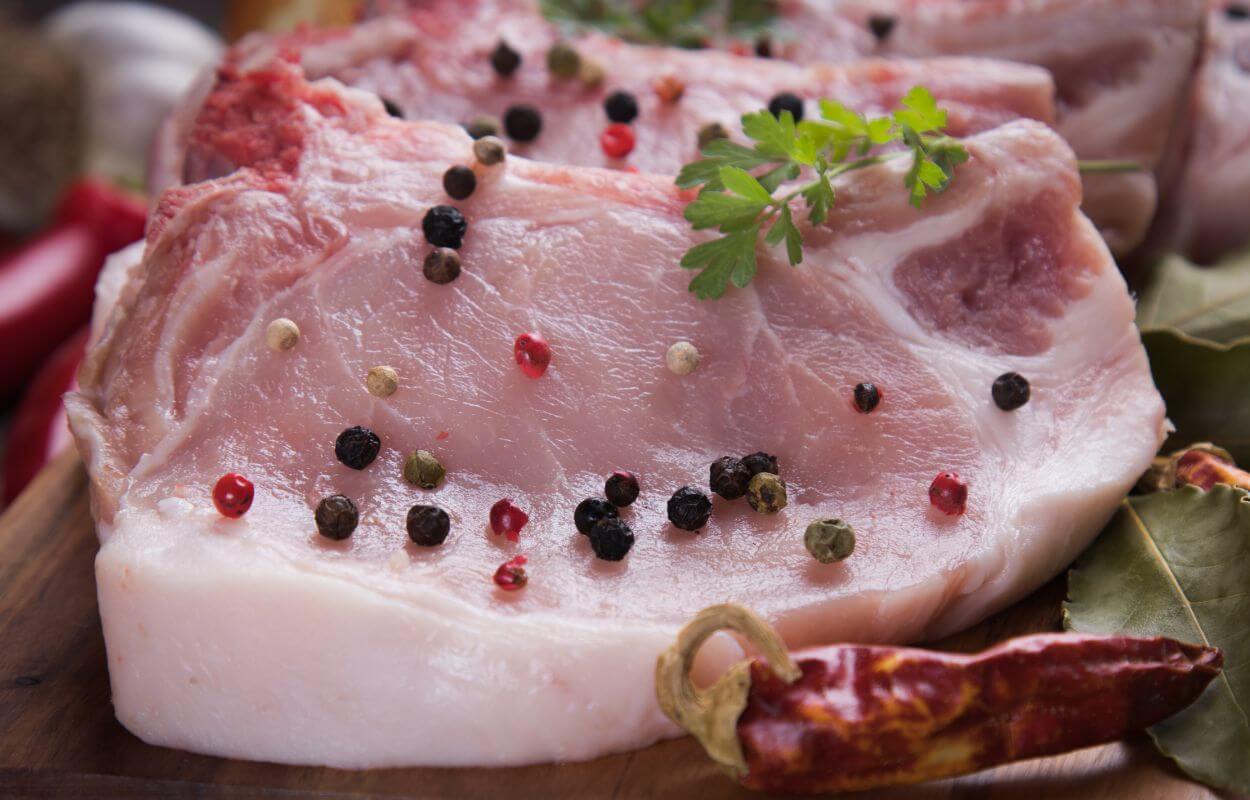
The meat of Landrace pigs is low in fat and is known to have superior quality.
It is lean, tender, and juicy, with a distinct flavor. The muscle texture is renowned for its firmness and lower fat content compared to other pig breeds.
The taste and flavor of Landrace pig meat are mild and delicate.
Additionally, the meat is rich in protein, vitamins like vitamin B, and minerals such as iron and zinc.
The meat is commonly used in various meat productions such as bacon, sausages, and pork chops for roasting or grilling.
Approximately 75% of the carcass weight can be obtained as meat.
According to some studies, Landrace pigs produce juicier meat compared to Duroc pigs, making them a good choice for meat production.
Growing Landrace Pig
When growing Landrace pigs, you need to consider certain aspects to ensure their optimal growth and development.
Feeding
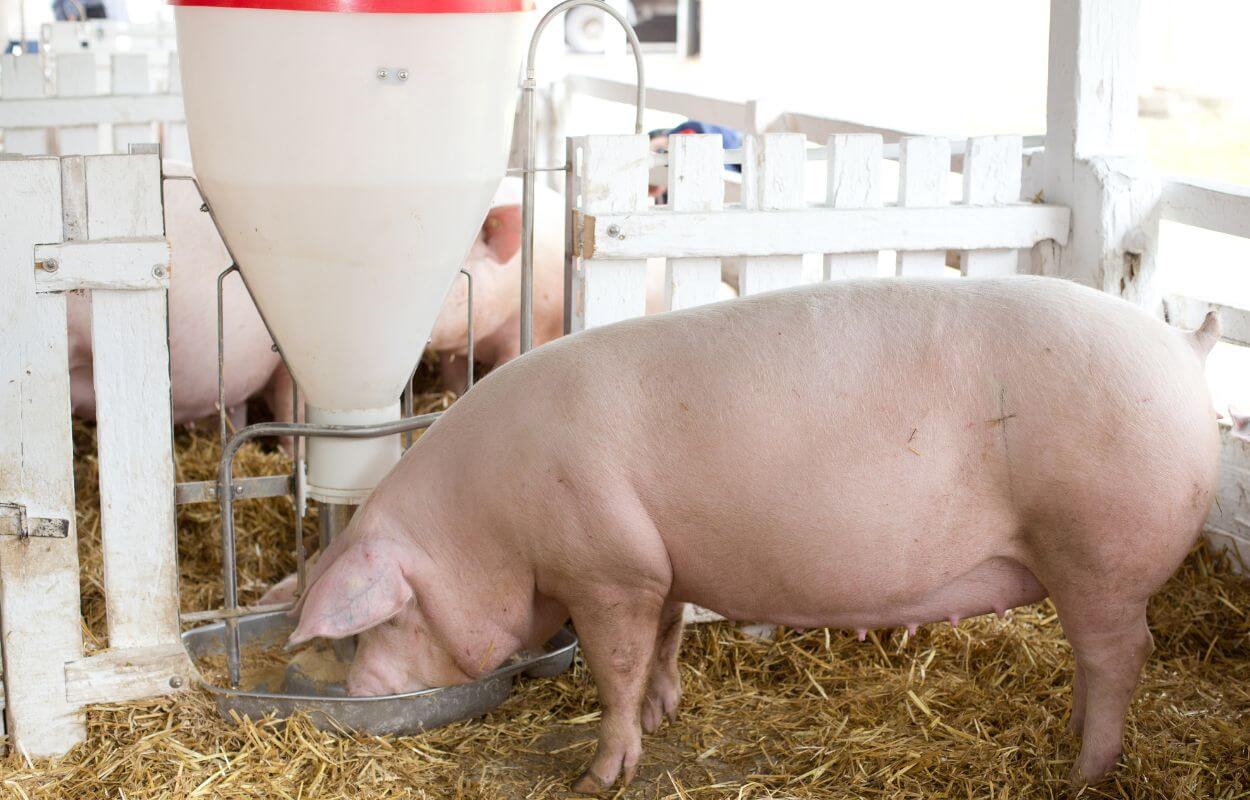
Landrace pigs can be fed with:
- grains and cereals such as crushed peas, buckwheat, barley, and wheat
- nettle, alfalfa, clover
- coarse fodder such as heavy bran and hay
- juicy fodder such as carrot, potato, fodder beet, pumpkin, and turnip
- dairy and different fruits
- vitamins and minerals
The ratio of all of the above must be 70% compound fodder and 30% green mass and juicy fodder.
The feed offered to the Landrace pig will influence the quality of the meat obtained. In general, your goal would be to obtain lean meat with low-fat content.
I suggest you reduce the intake of oats, rye, and corn, as these products have the potential to stimulate fat layer development. Similarly, the ratio of potatoes in the feed should be limited to one-third of the juicy fodder to prevent excessive fat accumulation.
Environment
Landrace pigs can be raised in both open environments and pig pens.
They adapt well to controlled housing systems as they do not require extensive exercise or large amounts of free space to move or explore. Providing sufficient space within the pig pen for comfortable movement is good enough.
However, if raised outdoors, Landrace pigs will naturally graze and root like any other pig, reflecting their natural instincts. It is important to ensure they are protected with a reliable electric fence when they have the freedom to roam. This is essential to maintain their safety.
Climate
Landrace pigs prefer a moderate temperament and are well-suited to environments with mild temperatures.
While they can adapt to challenging climates, it is important to provide them with suitable conditions to tolerate both hot and cold weather.
Shelter
Landrace pigs require shelter with proper air circulation and suitable bedding made from straw. The well-ventilated shelter provides effective protection against harsh weather conditions such as wind, rain, or intense sunlight.
The bedding offers a comfortable resting area with materials that absorb moisture, ensuring the pigs can rest comfortably without the risk of slipping or getting injured.
Breeding
Landrace pigs are primarily considered a maternal breed.
They are known for their great maternal instincts and their ability to produce large. But, it’s important to note that Landrace pigs can also contribute to terminal crosses, as their lean meat quality and growth rate make them suitable for meat production purposes as well.
The breeding of Landrace pigs can be done through natural mating or artificial insemination, depending on the preference of the pig farmer.
For natural mating, it is important to ensure that the sow or gilt is in heat before introducing her to the boar. Look for signs such as a swollen vulva, changes in behavior or mood, and aggression toward the boar. Once you observe these signs, you can place the sow or gilt together with the boar for mating.
In the case of artificial insemination, boar semen is collected or acquired and then administered to the sow or gilt when she is in heat using the appropriate tools and techniques.
Landrace pigs can be mated somewhere as young as 4-5 months.
The heat period in females usually lasts around 4 to 6 days. When the sow’s heat period begins, she will spend more time with other pigs, and immediately after mating, she will retreat to a narrower corner.
Landrace pigs are easy to breed and do not usually have reproductive issues.
Landrace sows have an increased prolificacy in reproduction, often giving birth to a large litter of 11-13 piglets. They are known for their great mothering skills.
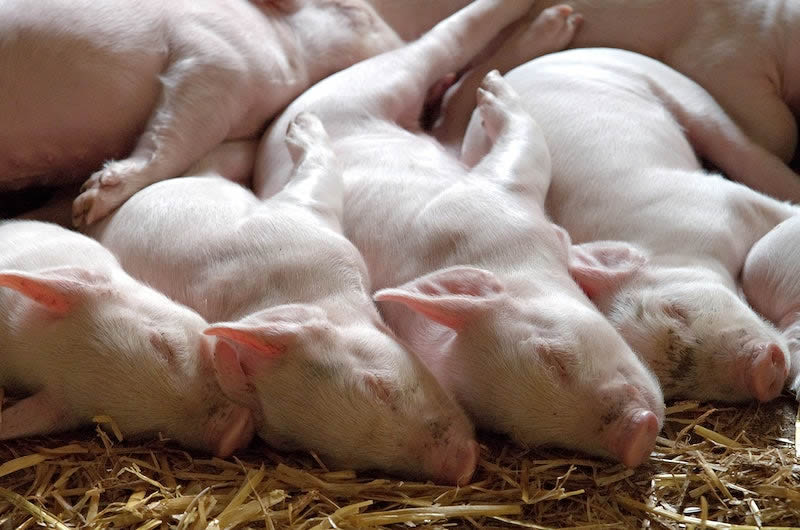
The gestation period for Landrace pigs is 114 days or 3 months, 3 weeks, and 3 days, which is consistent with other pig breeds.
Approximately 4-5 days before giving birth, you may observe signs of fetal movement in the sow, and around 7-8 hours prior to birth, the genital organs of the sow will swell.
The farrowing process typically lasts between 30 minutes to an hour.
Landrace piglets have rapid growth and weight gain, thanks to the exceptional maternal behavior of the sows. The sow provides direct care to the piglets after birth and feeds them with a good supply of milk of almost 114 lbs (52 kg).
Lactation will be stimulated by piglets, who generally do not need guidance to feed. They will find the sow’s nipples with the touch of their nose.
Good to know: If the number of piglets is less than the number of nipples, then you will notice how a piglet will prefer to eat at more than one nipple. The piglets will feed themselves about 30 times a day.
All that a farmer needs to do when there are new piglets on the farm is to ensure that the shelter provides optimal conditions for the piglets and to manage the heat inside the shelter to facilitate their proper development.
Health Issues
The most common health issues in Landrace pigs include:
- Respiratory diseases, including pneumonia, which is prevalent in various pig breeds. To prevent these diseases, it is important to ensure their shelter is well-ventilated and maintained in a clean condition.
- Joint and leg issues, such as stiffness, lameness, arthritis, and leg weakness. Due to their large body size and rapid growth rate, Landrace pigs may experience challenges in their joints and legs.
- Skin conditions, such as mange, lice infestation, and sunburn, can affect Landrace pigs. Proper hygiene, parasite control measures, and providing shade can help minimize these conditions.
- Other parasitic infections, including worms, mites, and ticks, are common health concerns. Regular deworming and appropriate parasite control protocols are essential to manage these infections.
Vaccination
Landrace pigs should be vaccinated to ensure their health and proper development.
When vaccinating them, you can follow the standard pig vaccination chart that is applicable to all kinds of pigs. This chart provides guidance on the recommended vaccinations to ensure their overall health and well-being.
How to Take Care of Landrace Pigs
To maintain Landrace pigs, you must first pay attention to the following two factors: hygiene and the climate of the stable.
They prefer to stay clean and in a moderate climate, so if these maintenance conditions are not maintained, then the productivity will decrease and the sows will give birth to a smaller number of Landrace piglets.
The maintenance of these pigs requires that you change their bedding often because they prefer to have dry and clean bedding.
You also have to provide them with a place to relax because Landrace pigs are full of energy. A green area with a small shelter from the strong sun is perfect for them. The barn where they are kept must have access to sunlight and not have a temperature lower than 68°F (20°C) all year round.
If the temperature is lower than that or if the barn is not naturally lit, then the Landrace pigs tend to get sick.
Should you raise Landrace pig?
Profitability
It is definitely worth raising Landrace pigs as they are a profitable pig breed.
Unlike pasture pigs like Mangalica or Red Wattle pigs, Landrace can be raised in smaller spaces and even non-free systems, making them suitable for small-scale farmers with limited space or no access to pasture.
With a single farrowing, you can expect around 13 new piglets, increasing the potential for profitability.
Raising Landrace pigs can generate income in various ways. Landrace pig meat is commonly used to make bacon and various other meat products, making it a valuable product to sell in those markets. It can also be supplied to local restaurants or businesses.
The market price for Landrace pig meat ranges from $5 to $6 per pound.
Furthermore, you have the option of breeding and selling them as adults to other pig farmers or for slaughter for those who just want the meat.
Adult Landrace pigs can be sold at a price of $200 to $250 each.
In summary, they offer a profitable opportunity for farmers to generate income. Whether selling their meat, piglets, breeding stock or slaughtered pigs, Landrace pigs can contribute to a successful and profitable farming business.
Personal Use
Landrace pigs can be raised even in homesteads.
They do not require extensive care and provide a substantial amount of lean meat that can feed an entire family.
From a 230 lbs (105 kg) pig, you can obtain a yield of meat that is approximately 75%, which means approximately 170 lbs (77 kg).
Also, they have a calm and docile nature, making them suitable for novice pig raisers who may have limited experience.
Advantages & Disadvantages
Like any other breed, Landrace pigs have their advantages and disadvantages. However, in the case of this breed, the ups are much more numerous than the downsides.
| Advantages | Disadvantages |
|
|
FAQs
What is Landrace pig used for?
Landrace pig is used for meat production and for crossbreeding programs to enhance the traits of other pig breeds.
Their maternal qualities, such as large litter size and good mothering abilities, make them valuable for producing crossbred piglets with desirable characteristics.
With which breed can a Landrace pig be crossbred?
Landrace pigs can be crossbred with Duroc pigs, Large White pigs, Yorkshire pigs, and Berkshire pigs. These are some of the most common breeds that are crossbred with Landrace.
Conclusion
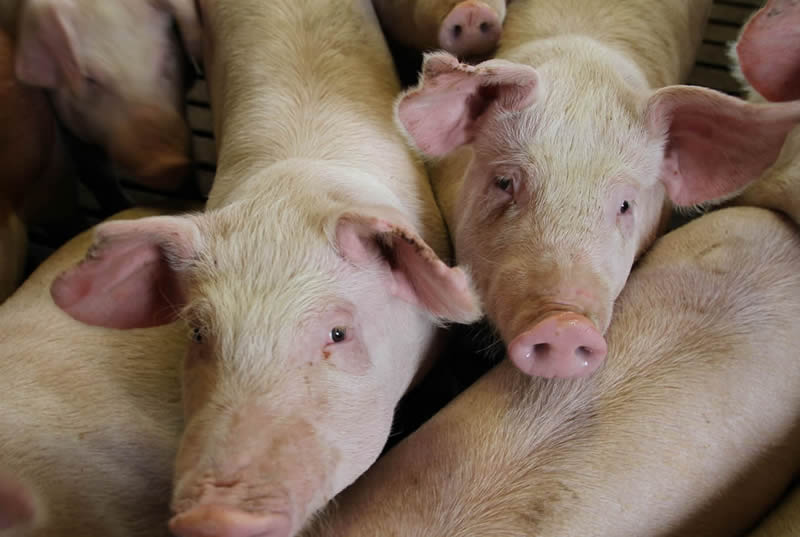
In conclusion, if you decide to open a pig farm, Landrace pigs are a good choice as they are easy to raise, not too demanding, and with increased productivity.


It’s great reading this from Ghana 🇬🇭 , West Africa. As a young guy trying to know more about pigs 🐖 and Landrace especially. I’m very glad to have learned about my experience in our farm.
They are lovely pigs to have in your farm. Calm. Lovely. Profitable.
Hi Wisdom,
Thank you for sharing your experience with Landrace pigs, and I’m glad to hear that you found the information helpful. Landrace pigs are indeed known for their calm temperament and profitability, making them a popular choice among pig farmers worldwide.
It’s always great to see young people like yourself taking an interest in agriculture and seeking to learn more about livestock farming. Wishing you all the best with your farming endeavors!
Am reading this from Nigeria🇳🇬 , am having interest in pig farming and this post has really help a lot. I really want to learn more